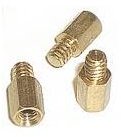How to Install Motherboard Standoffs
Motherboard Standoffs
Motherboard standoffs serve the very important purpose of keeping the motherboard from making too much contact with the computer case. They are installed underneath the motherboard in a way that prevents the underside of the board from touching the metal interior of the case. In this article, we’ll discuss how to install them and why they are so important.
Note: Your new motherboard should include standoffs as well as screws, and you need to make sure the threads are compatible before you proceed.
How to Install Motherboard Standoffs
The first time you get ready to install a motherboard in a computer case, you will have to figure out where to install your standoffs first. The interior wall of your computer case should be covered in threaded screw holes that allow the case to take a variety of board configurations. You have to use the ones made specifically to fit your motherboard, so don’t just randomly screw in the standoffs.
The easiest way to determine which threaded holes to use is to very carefully place the motherboard inside the case so that you can see how the screw holes in the board line up with the holes on the inside of the case. Once you have them all lined up, use a felt tip marker or Sharpie to make a mark on each screw hole. Be careful not to mark on the motherboard itself. Once you have all the screw holes marked, take the motherboard out of the case and install your motherboard standoffs.
It is recommended that you use a pair of pliers to securely attach the standoffs. Be sure to tighten them well, but don’t overdo it. I don’t recommend using any kind of glue or adhesive to hold them in place because of issues with heat and the chemicals involved.
(Image credit: Tomshardware.com)
Motherboard Installation Tips
Once you have your standoffs in place, put the motherboard back inside the case and make sure all the holes line up before you tighten down the first screw. Be careful not to over tighten the screws because you could strip out the threads of the standoff underneath. Also, make sure the screw is lined up properly before you tighten. You do not want to force the screws in because you could possibly damage your motherboard or make it very difficult to remove the screws later on. Also avoid using magnetic tipped screwdrivers as magnets and computer components don’t always get along so well.
Why Use Motherboard Standoffs?
If you look at the bottom of a motherboard, you will see dozens of tiny metal pins sticking out. These are from all the capacitors and other components that are soldered onto the main board. You do not want any of those pieces touching the metal frame of your case because that could cause your motherboard to malfunction and potentially damage it. The standoffs raise the motherboard just enough so that it doesn’t sit directly against the case siding, plus it helps with heat dissipation by adding a little breathing room between the case and the board.
For more information, be sure to check out how to install a new motherboard.
